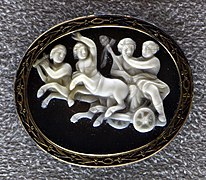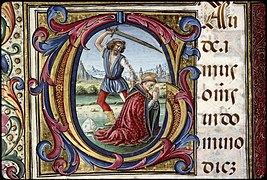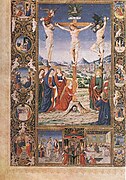The Missal of Thomas James
| The Missal of Thomas James | |
|---|---|
 Frontispiece of the missal, fo 6 vo. | |
| Artist | Attavante degli Attavanti |
| Year | c. 1483-1484 |
| Medium | Oil on poplar panel |
| Dimensions | 39,2 cm × 28 cm (154 in × 11 in) |
| Location | Bibliothèque municipale de Lyon, Lyon |
| Accession | Ms 5123, Inv. 36.1 |
The Missal of Thomas James is an
History
Context of creation
Attavante degli Attavanti, the painter who signed the manuscript (fo 6 vo), was a famous illuminator painter of the late 15th century. Many aristocrats and prelates from all over Europe sought to obtain a manuscript decorated by his hand, including Federico da Montefeltro, Duke of Urbino, Matthias Corvinus, King of Hungary, Manuel I, King of Portugal, Georges d'Amboise, Archbishop of Rouen, and Lorenzo de' Medici.[1] The latter, through his diplomatic relations with Rome, helped to introduce Florentine artists to the papal city. Between 1477 and 1483, Sixtus IV invited the city's best artists to decorate the Sistine Chapel. Among them was Domenico Ghirlandaio, an artist who profoundly influenced the style of Attavante, with whom he probably collaborated. In particular, together with Domenico's brother Davide,[2] they collaborated on the decoration of the Bible of Federico da Montefeltro. In this context, one of the first works identified as coming from his studio was commissioned by a Breton monk living in Rome.
Patron and date


The patron of this work can be identified by his coat of arms, which appears several times in the margins of the manuscript: "D'or, au chef d'azur chargé d'une rose d'or", which corresponds to that of Thomas James. He was a native of Saint-Aubin-du-Cormier with a doctorate in utroque jure, he pursued an ecclesiastical career in Brittany, holding several religious offices, including the title of archdeacon of Penthièvre. As a close friend of Pierre Landais, advisor to Francis II, Duke of Brittany, he began a career as a diplomat at the Holy See in Rome, which he joined in the 1470s, becoming a close friend of Pope Sixtus IV. He was appointed Bishop of Léon in 1478 (a bishopric to which he never returned), Governor of Castel Sant'Angelo at the end of 1478, and then Bishop of Dol in 1482. At that time he belonged to the entourage of Cardinal Guillaume d'Estouteville, Archbishop of Rouen, who probably introduced him to artistic circles. The humanist Giulio Pomponio Leto dedicated a Latin grammar to him in 1483, and he had an episcopal seal[3][4] engraved by Roman artisans.
The commission for the missal is known from two letters signed by the Florentine painter Attavante degli Attavanti, dated 1483 and 1484. They are addressed to Taddeo Gaddi (a descendant of the Florentine painter of the same name), who lived in the papal city and was responsible for supervising the production of the work on behalf of the client. The painter signed his letters "le miniaturiste de l'évêque de Dol" ("miniatore del vescovo di Dolo" in Italian). This commission, worth almost 200 ducats, probably dates back to his appointment as bishop of Dol. In July 1483, following the escape of a prisoner from the Castel Sant'Angelo,Thomas James was relieved of his governorship. James left Rome at the end of that year, probably because of the death of Cardinal d'Estouteville before the work was completed. It was his nephew François who enabled him to recover it in Florence in 1484, through the Rinieri family. Attavante signs the work on the frontispiece and gives the date of its creation: 1483.[5][6]
History of the manuscript
The
Throughout its history, the manuscript has undergone several changes, including the removal of five sheets. Only one of these has been located: the Crucifixion, which is currently in the Museum of Modern Art André Malraux in Le Havre, where it was acquired in 1903 as a bequest from the Langevin-Berzan family. It is not known when the sheets were removed from the manuscript. It may have been cut out between the time it left Dol and its arrival in Lyon. It may also have been detached in the 18th century when it was rebound.[2]
Description

Codicology
The work contains the traditional text of Roman missals in Latin:[11][12]
- A General Roman Calendar (fo 1-5 vo), the only particularity being the insertion of Saint Yves on October 27.
- The proper of Advent to the 25th Sunday after Pentecost (fo 6 vo-280), with the Mass in the Catholic Church inserted from folio 203.
- The proprer of saints (fo 280 vo-358).
- The commun of saints, dedication, votive Masses , and blessings (fo 358 vo-430).
The text is written in two columns of 26 lines each. It consists of 430 folio parchment sheets forming 8-sheet quires. The sheets, which measure 39.2 × 28 cm, were slightly cut when they were rebound in the 18th century. The manuscript is incomplete since five sheets are missing. Among the missing sheets are the one containing the months of November and December in the calendar (before the frontispiece, (fo 6 ro), as well as the sheet for the service on the first Sunday of Advent, after the frontispiece. Also missing from the center of the manuscript are the sheet before the beginning of the canon, the second one of the same canon, and the final sheet marking the beginning of the Easter service.
Decoration
The
Frontispiece
The
It is surrounded by architectural and sculptural elements inspired by antiquity and the Florentine Renaissance. A two-story loggia facing a palace inspired by the Palazzo Medici Riccardi in Florence can be seen in the left background. The right background shows a building inspired by the Baptistery of Saint John in Florence facing another Roman basilica-inspired building. The artist's signature appears at the bottom: "ACTAVANTE DE ACTAVANTIBUS DE FLORENTIA / HOC OPUS ILLUMINAVIT + D MCCCCLXXXIII". The margin is decorated with numerous scrolls surrounding medallions that form small scenes. The medallions in the four corners depict sibyls dressed in the Florentine style. The medallion in the center left represents St. Antoninus of Florence, while the medallion in the center right represents St. Bonaventure. Six other medallions reproduce antique cameos from Lorenzo de' Medici collections. The two lower ones depict Bacchus discovering Ariadne in Naxos, and Le Char d'Ariane et de Bacchus trainé par des Psychés (now in the National Archaeological Museum of Naples). In the lower center margin, there is the coat of arms of the bishop, held by two cherubs.[14]
- Examples of ancient artworks similar to the models used for the frontispiece decorations
-
Cameo depicting Bacchus surprising Ariadne, coll. National Archaeological Museum of Florence.

Incipit of the Canon of the Mass
The other fully decorated page preserved in the manuscript is the beginning of the Canon of the Mass (fo 203 ro). The upper part of this page contains a miniature depicting the Last Judgement. The patron, Thomas James, is shown kneeling before St. Michael, bareheaded and tonsured. His face is barely represented, the painter had adopted an almost profil perdu to avoid drawing the features of a model he probably never met. The background of the scene shows landscapes inspired by Tuscany and a town with a church within its walls, inspired by the Cathedral of Saint Mary of the Flower in Florence. In the lower-left corner, the T of "Te Igitur" is covered by a small painting depicting the Resurrection of Jesus. Twelve medallions depicting episodes before and after this scene of the gospel are placed in the decorated margin of the page: The Descent from the Cross, the Pietà, the Burial of Jesus, the Descent into Limbo, the Holy Women at the Tomb in the left margin from top to bottom. At the bottom of the page in two square vignettes: Noli me tangere and the Disciples of Emmaus. In the right margin from bottom to top: The Incredulity of Saint Thomas, the Ascension, the Assumption, and the Coronation of the Virgin. At the bottom of the page, the coat of arms of Thomas James appears again between two angels.[15]
Le Havre Folio

The Havre Folio contains the Crucifixion, which was placed opposite Folio 203. Based on the canons of 15th-century Florentine painting, the full-page miniature is in the form of a small painting. It incorporates the influences of Early Netherlandish painting (once known as Flemish Primitives) with its attention to detail in landscapes lightly shrouded in mist and its rendering of materials. In the same position as on the previous page, but reversed, Thomas James is again depicted in a youthful blue robe, kneeling at the foot of St. John, bareheaded and tonsured. The city in the background shows several Roman monuments such as the dome of the Pantheon, the walls around St. Peter's Basilica, and the Castel Sant'Angelo. In the crowd is a red banner with the letters SPQR.[2][16]
The gilded frame surrounding the scene depicts episodes from the life of Jesus and his Passion. On the left are the Joyful Mysteries: from top to bottom, the Annunciation, the Nativity, the Epiphany, the Circumcision, Christ among the Doctors and, at the bottom left of the page, the Baptism. This last scene is a reproduction of the Baptism of Christ painted by Andrea del Verrocchio and Leonardo da Vinci. On the right, it's the Passion,[17] beginning with the Last Supper at the bottom right, then, from bottom to top, the Sorrowful Mysteries: La Prière dans le Jardin des oliviers (The Prayer in the Garden of Olives), the Arrest of Jesus, Jesus before Pilate, the Flagellation, to the Christ Carrying the Cross and the Crucifixion for the main scene.[16][18]
Incipit of the commun of saints and secondary decoration
The last and most decorated page is the
-
Le Paradis céleste, fo 358 vo.
-
Example of a decorated page from the first part, fo 29 vo.
-
Detail of a margin medallion: shepherds, fo 29 vo.
-
Example of a decorated page from the second part, fo 394 vo.
Attribution of the decoration
Not all of the illuminations in the
-
Page with a frame attributed to the people of the studio and an initial to the artist, the Nativity, fo 16 vo
-
Example of an initial attributed to a collaborator, Évêque devant un autel, fo 394 vo.
Attavante's influence on other manuscripts
The decorations of the
-
Book of Hours with large initial of the Adoration du Christ (Adoration of Christ), Fitzwilliam Museum, Ms.154, fo 13 ro-fo 14 ro.
See also
Bibliography
- Delisle, Léopold (1882). LE MISSEL DE THOMAS JAMES ÉVÊQUE DE DOL: LETTRE A M. LE COMTE AUGUSTE DE BASTARD (in French). Vol. 43. Bibliothèque de l’École Des Chartes. pp. 311–315.
- Bertaux, Émile; Birot, G. (1906). "Le Missel de Thomas James, évêque de Dol". La Revue de l’art ancien et moderne (in French). 20: 129–146. ISSN 2021-0663.
- Leroquais, Victor (1924). Les sacramentaires et les missels manuscrits des bibliothèques publiques de France (in French). Vol. 3. Paris. pp. 223–225.
{{cite book}}: CS1 maint: location missing publisher (link) - Joly, Henry (1931). Le missel d'Attavante pour Thomas James, évêque de Dol (in French). Lyon: les Amis de la Bibliothèque de Lyon.
- Bresc-Bautier, Geneviève; Crépin-Leblond, Thierry; Taburet-Delahaye, Elisabeth (2010). France 1500 : entre Moyen âge et Renaissance (Catalogue de l’exposition du Grand Palais à Paris) (in French). Paris: RMN. p. 360. ISBN 978-2-7118-5699-2.
- Hatot, Nicolas; Jacob, Marie (2016). Trésors enluminés de Normandie. Une (re)découverte (in French). PU DE RENNES. pp. 255–256. ISBN 9782753551770.
- Booton, Diane E. (2018). "Le mécénat et l'acculturation italienne de Thomas James, évêque de Dol-de-Bretagne, à la fin du xve siècle". Livres manuscrits et mécénat du Moyen Âge à la Renaissance (in French). Vol. 21. Brepols: Pecia. Le livre et l’écrit. pp. 231–258. ISSN 2295-970X.
- Labriola, Ada (2008). Firenze e gli antichi Paesi Bassi 1430-1530 dialoghi tra artisti: da Jan van Eyck a Ghirlandaio, da Memling a Raffaello... (in Italian). Florence: Sillabe. pp. 111–112. ISBN 978888347730-0.
- "Ms 5123 // Missel". Bibliothèque Municipale de Lyon (in French).
Related articles
External links
- Fine arts resource: Manuscrit : missel de Thomas James, évêque de Dol (in French)
- Missel romain, dit missel d'Attavante. Commanditaire Thomas James, évêque de Dol (in French)
- Missel romain (in French)
- The Joyful Mysteries
References
- ^ Ferretti, Patrizia. "Attavanti, Attavante [Vante di Gabriello di Vante Attavanti]". Grove Art Online.
- ^ a b c d Labriola (2008, p. 111)
- ^ Bertaux & Birot (1906, pp. 129–130)
- ^ Osmond, Patricia. "Thomas James". Repertorium Pomponianum. (With additions by Diane Booton).
- ^ Bertaux & Birot (1906, pp. 130–131)
- ^ a b Bresc-Bautier, Crépin-Leblond & Taburet-Delahaye (2010, p. 360)
- ^ Delisle, Léopold (1882). Le missel de Thomas James, évêque de Dol. Lettre à Mr le comte Auguste de Bastard (in French). Vol. 43. Bibliothèque de l'École des chartes. pp. 311–315.
- ^ Bertaux & Birot (1906, pp. 131–132)
- ^ "Manuscrit : missel de Thomas James, évêque de Dol". Ministère français de la Culture. (in French).
- ^ a b Missel d'Attavante
- ISBN 2870930801.
- ^ Bertaux & Birot (1906, p. 133)
- ISBN 9781905375608.
- ^ Bertaux & Birot (1906, pp. 135, 136, 145, 146)
- ^ Bertaux & Birot (1906, pp. 136, 144)
- ^ a b Hatot & Jacob (2016)
- ISBN 978-2843981265.
- ^ Bertaux & Birot (1906, pp. 142, 145)
- ^ a b Bertaux & Birot (1906, pp. 136–138)
- ^ Labriola & (2008, p. 112)
- ISBN 2870930801.
- ^ Bertaux & Birot (1906, pp. 139–140.)
- ISBN 978-1-909400-56-6.














